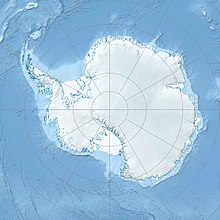Wilkins Ice Shelf
Coordinates: 70 ° 15 ′ 0 ″ S , 73 ° 0 ′ 0 ″ W.
The Wilkins Ice Shelf (sometimes incorrectly called the Wilkins Shield) is an ice shelf over the Wilkins Sound, named after Hubert Wilkins , on the west coast of Alexander I Island in Antarctica . It borders in the east and in the south on the Alexander-I-Island, in the west on the Latady-Island and until April 2009 extended in a north-westerly direction to the Charcot-Island . In the north it borders on Rothschild Island . In the 1950s, the Wilkins Ice Shelf extended over an area of 16,000 km², which decreased to 11,200 km² by March 2009. With around 1% of the total Antarctic ice shelf area, the Wilkins Ice Shelf is one of the small ice shelves.
An ice shelf is created when the glaciers slide into the sea. Therefore, on the ice front towards the sea, icebergs and tablets break off constantly, controlled by the advancing ice and the air and water temperature.
Increased breakup of the Wilkins Ice Shelf has been observed since 1995, which is probably due to the above-average warming of the West Antarctic since around 1950. Meanwhile, the mean annual surface temperature in the area of the Wilkins Ice Shelf is above −9 ° C, and thus beyond the limit temperature for the long-term survival of ice shelves. In the summer of 2008, new cracks were discovered in the remaining shelf, which suggested that it would break off again soon. Observations by the Earth observation satellite TerraSAR-X operated by the German Aerospace Center and the Envisat operated by ESA revealed an ice loss of 1,800 km² in 2008, which corresponds to a decrease of 14% of the total area available at the beginning of 2008. On April 2, 2009, the remaining ice bridge to Charcot Island finally broke . Parts of the ice shelf have been drifting into the open sea since then. As a result, the ice shelf area decreased by a further 1,030 km². Since the ice shelf is already floating in the water, its breaking does not initially result in an increase in sea level. However, it is believed that the ice shelf had a slowing influence on the flow speed of the glaciers on the adjacent islands.
Web links
- 'Webcam' from Space Envisat Advanced Synthetic Aperture Radar (ASAR)
- NASA Earth Observatory, Image of the day April 8, 2009
- NASA Earth Observatory, Image of the day April 19, 2009
- NASA Earth Observatory, Image of the day August 14, 2009
Individual evidence
- ↑ Ferrigno, JG, Cook, AJ, Mathie, AM, Williams, RS, Jr., Swithinbank, Charles, Foley, KM, Fox, AJ, Thomson, JW, and Sievers, Jörn, 2009, Coastal-change and glaciological map of the Palmer Land area, Antarctica: 1947-2009: US Geological Survey Geologic Investigations Series Map I-2600-C, 1 map sheet, 28-p. text.
- ↑ Cook, AJ and Vaughan, DG (2010) 'Overview of areal changes of the ice shelves on the Antarctic Peninsula over the past 50 years.', The cryosphere., 4 (1). pp. 77-98.
- ^ Deutsche Welle : Gigantic ice block breaks off in Antarctica, March 26, 2008.
- ↑ Spiegel Online : Satellite Image of the Week: The End of the Wilkins Ice Shelf, March 28, 2008.
- ↑ Angelika Humbert : Northern ice front of the Wilkins Ice Shelf is becoming unstable. (No longer available online.) Westfälische Wilhelms-Universität Münster , Institute for Geophysics, Polar Physics Working Group, April 28, 2009, archived from the original on December 15, 2009 ; Retrieved December 12, 2009 . Info: The archive link was inserted automatically and has not yet been checked. Please check the original and archive link according to the instructions and then remove this notice.
- ↑ Spiegel Online: Wilkins Ice Shelf threatened with rapid demolition, July 13, 2008.
- ↑ Northern ice front of the Wilkins Ice Shelf becomes unstable. German Aerospace Center , April 28, 2000, accessed December 12, 2009 .
- ↑ Jane G. Ferrigno, Alison J. Cook, Amy M. Mathie, Richard S. Williams, Jr., Charles Swithinbank, Kevin M. Foley, Adrian J. Fox, Janet W. Thomson, and Jörn Sievers: Coastal-Change and Glaciological Map of the Palmer Land Area, Antarctica: 1947-2009. USGS , February 19, 2010, accessed February 23, 2010 .
- ^ ESA: Keeping an eye on Wilkins Ice Shelf, April 16, 2009.



